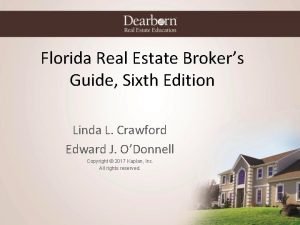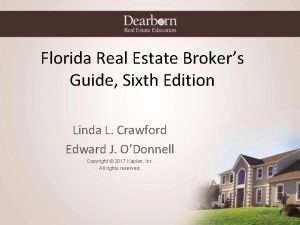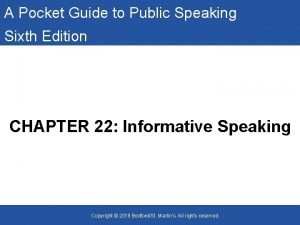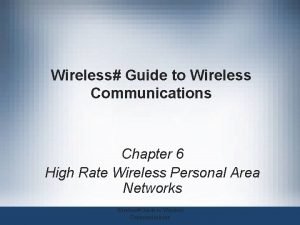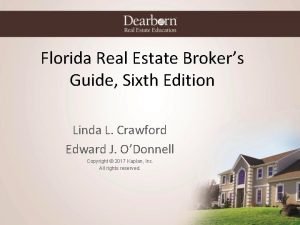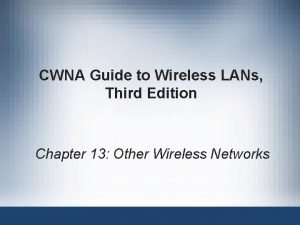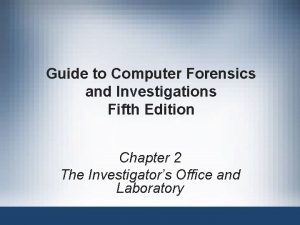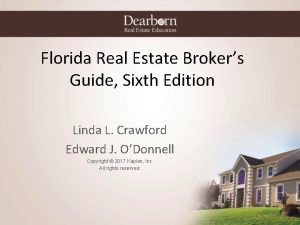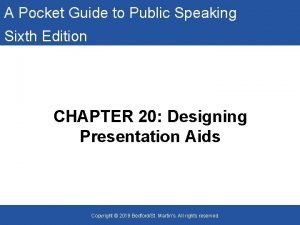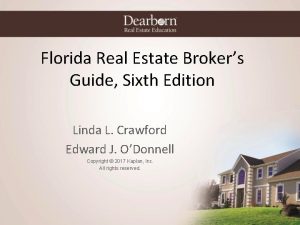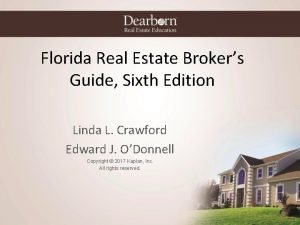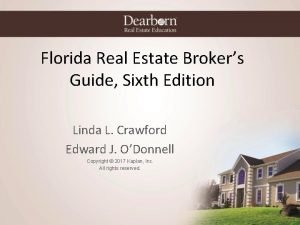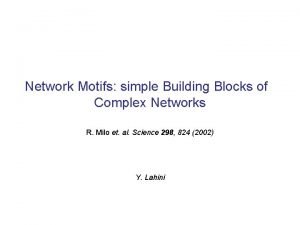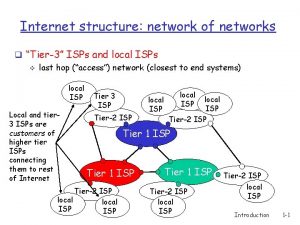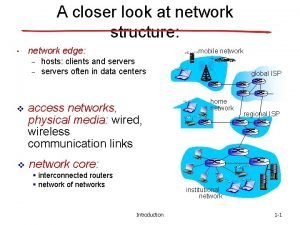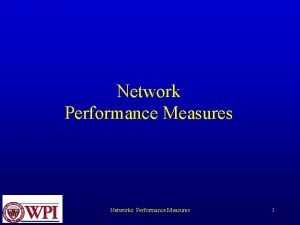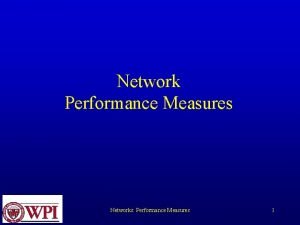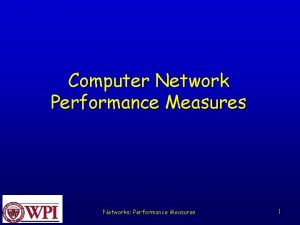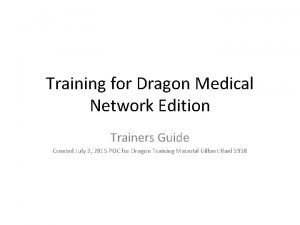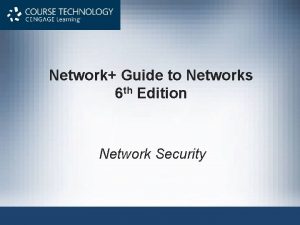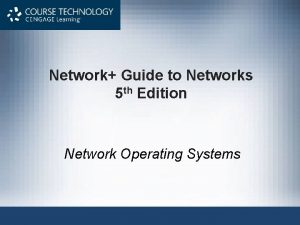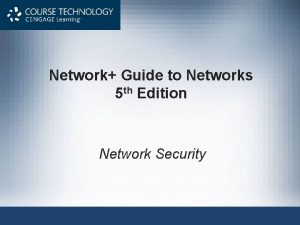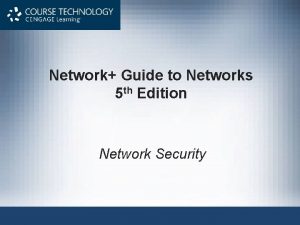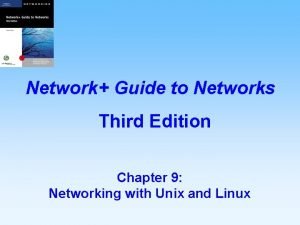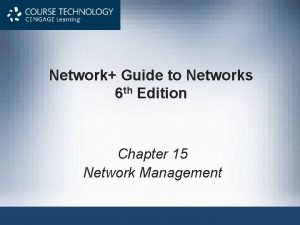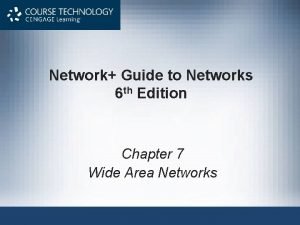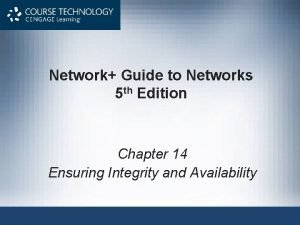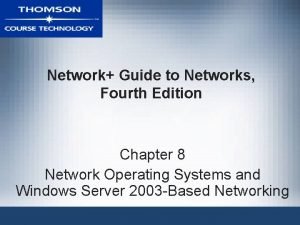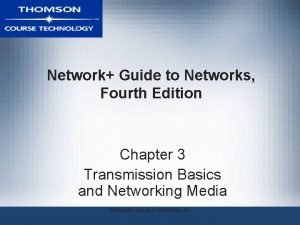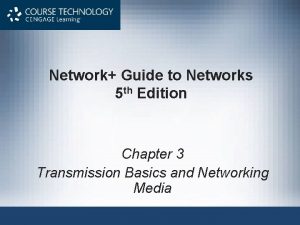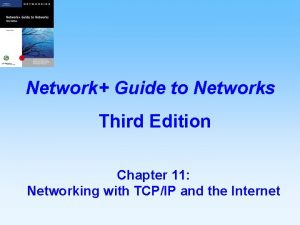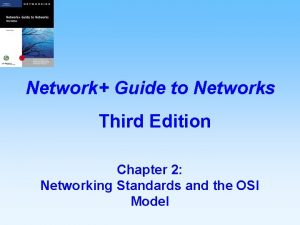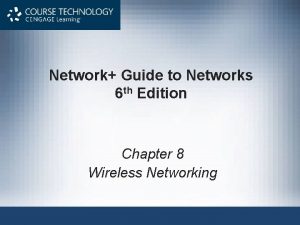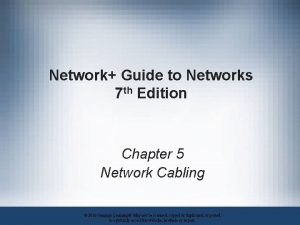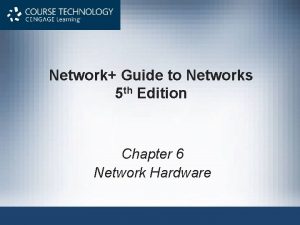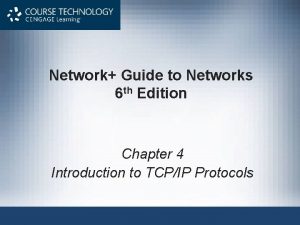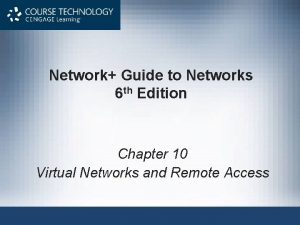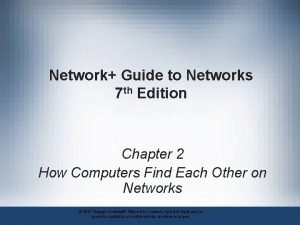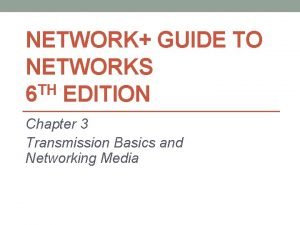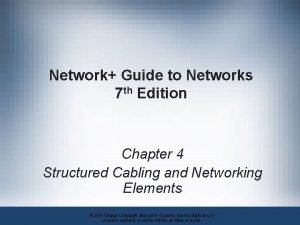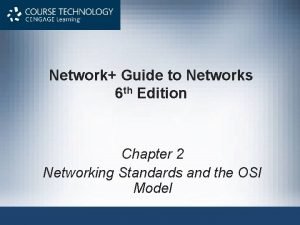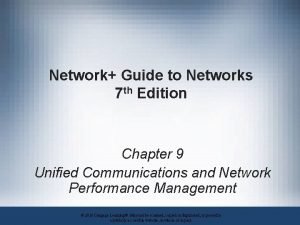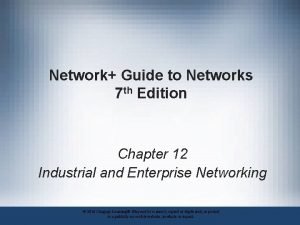NETWORK GUIDE TO NETWORKS 6 TH EDITION CHAPTER







































- Slides: 39

NETWORK+ GUIDE TO NETWORKS 6 TH EDITION CHAPTER 5 TOPOLOGIES AND ETHERNET STANDARDS

OBJECTIVES • Describe the basic and hybrid LAN topologies, and their uses, advantages, and disadvantages • Describe the backbone structures that form the foundation for most networks • Compare the different types of switching used in data transmission • Explain how nodes on Ethernet networks share a communications channel • Identify the characteristics of several Ethernet standards NETWORK+ GUIDE TO NETWORKS, 6 TH EDITION 2

SIMPLE PHYSICAL TOPOLOGIES Physical topology § Physical network nodes layout § Depicts broad scope § Does not specify: § Device types § Connectivity methods § Addressing schemes Fundamental shapes § Bus, ring, star § Hybrid NETWORK+ GUIDE TO NETWORKS, 6 TH EDITION 3

BUS Bus topology § Single cable § Connects all network nodes § No intervening connectivity devices § One shared communication channel Physical medium § Coaxial cable Passive topology § Node listens for, accepts data § Uses broadcast to send NETWORK+ GUIDE TO NETWORKS, 6 TH EDITION 4

Figure 5 -1 A terminated bus topology network Courtesy Course Technology/Cengage Learning NETWORK+ GUIDE TO NETWORKS, 6 TH EDITION 5

RING Ring topology § Node connects to nearest two nodes § Circular network § Clockwise data transmission § One direction (unidirectional) around ring § Active topology § Workstation participates in data delivery § Data stops at destination § Physical medium § Twisted pair or fiber-optic cabling Drawbacks § Malfunctioning workstation can disable network § Not very flexible or scalable NETWORK+ GUIDE TO NETWORKS, 6 TH EDITION 6

STAR Star topology § Node connects through central device § Router or switch Physical medium § Twisted pair or fiber-optic cabling Single cable connects only two devices Advantage § Fault tolerant § Flexible NETWORK+ GUIDE TO NETWORKS, 6 TH EDITION 7

BACKBONES Cabling connecting switches and routers More throughput Large organizations § Fiber-optic backbone § Cat 5 or better for hubs, switches Enterprise-wide network backbones § Complex, difficult to plan Enterprise § Entire organization § Significant building block: backbone NETWORK+ GUIDE TO NETWORKS, 6 TH EDITION 8

SERIAL BACKBONE Backbone components § Gateways, routers, switches Figure 5 -6 A serial backbone Courtesy Course Technology/Cengage Learning NETWORK+ GUIDE TO NETWORKS, 6 TH EDITION 9

DISTRIBUTED BACKBONE Connectivity devices § Connected to hierarchy of central connectivity devices Benefit § Simple expansion, limited capital outlay More complicated distributed backbone § Connects multiple LANs, LAN segments using routers NETWORK+ GUIDE TO NETWORKS, 6 TH EDITION 10

Figure 5 -7 A simple distributed backbone Courtesy Course Technology/Cengage Learning NETWORK+ GUIDE TO NETWORKS, 6 TH EDITION 11

SWITCHING Logical network topology component Determines connection creation between nodes Three methods § Circuit switching § Packet switching § Multiprotocol label switching NETWORK+ GUIDE TO NETWORKS, 6 TH EDITION 12

CIRCUIT SWITCHING Connection established between two network nodes § Before transmitting data Dedicated bandwidth Data follows same initial path selected by switch Monopolizes bandwidth while connected § Resource wasted Uses § Live audio, videoconferencing § Traditional telephone calls Remember frequency division multiplexing? NETWORK+ GUIDE TO NETWORKS, 6 TH EDITION 13

PACKET SWITCHING Most popular Breaks data into packets before transporting Packets § Travel any network path to destination § Find fastest path available at any instant § Need not follow each other § Need not arrive in sequence § Reassembled at destination (seq number, ip header) Requires speedy connections for live audio, video transmission NETWORK+ GUIDE TO NETWORKS, 6 TH EDITION 14

MPLS (MULTIPROTOCOL LABEL SWITCHING) Introduced by IETF in 1999 Enables multiple types of Layer 3 protocols: § To travel over any one of several Layer 2 protocols Most often supports IP Common use § Layer 2 WAN protocols (see WAN chapter) Offers potentially faster transmission than packet- or circuitswitched networks (Qo. S) NETWORK+ GUIDE TO NETWORKS, 6 TH EDITION 15

ETHERNET Most popular networking technology used on modern LANs Benefits § Flexible § Can run on various network media § Excellent throughput § Reasonable cost All variations § Share common access method § CSMA/CD NETWORK+ GUIDE TO NETWORKS, 6 TH EDITION 16

CSMA/CD (CARRIER SENSE MULTIPLE ACCESS WITH COLLISION DETECTION) Network access method § Controls how nodes access communications channel § Necessary to share finite bandwidth Carrier sense § Ethernet NICs listen, wait until free channel detected Multiple access § Ethernet nodes simultaneously monitor traffic, access media NETWORK+ GUIDE TO NETWORKS, 6 TH EDITION 17

CSMA/CD (CONT’D. ) Collision § Two nodes simultaneously: § Check channel, determine it is free, begin transmission Collision detection § Manner nodes respond to collision § Requires collision detection routine § Enacted if node detects collision § Jamming § NIC issues 32 -bit sequence § Indicates previous message faulty NETWORK+ GUIDE TO NETWORKS, 6 TH EDITION 18

Figure 5 -12 CSMA/CD process Courtesy Course Technology/Cengage Learning NETWORK+ GUIDE TO NETWORKS, 6 TH EDITION 19

Figure 5 -13 Broadcast domains and collision domains Courtesy Course Technology/Cengage Learning NETWORK+ GUIDE TO NETWORKS, 6 TH EDITION 20

IEEE STANDARDS FOR COPPER CABLE IEEE Physical layer standards § Specify how signals transmit to media § Differ significantly in signal encoding § Affect maximum throughput, segment length, wiring requirements NETWORK+ GUIDE TO NETWORKS, 6 TH EDITION 21

ETHERNET STANDARDS FOR COPPER CABLE (CONT’D. ) 10 Base-T § 10 represents maximum throughput: 10 Mbps § Base indicates baseband transmission § T stands for twisted pair § Two pairs of wires: transmit and receive § Full-duplex transmission § Follows 5 -4 -3 rule of networking § Five network segments § Four repeating devices § Three populated segments maximum NETWORK+ GUIDE TO NETWORKS, 6 TH EDITION 22

Figure 5 -14 A 10 Base-T network Courtesy Course Technology/Cengage Learning NETWORK+ GUIDE TO NETWORKS, 6 TH EDITION 23

ETHERNET STANDARDS FOR COPPER CABLE (CONT’D. ) 100 Base-T (Fast Ethernet) § IEEE 802. 3 u standard § Similarities with 10 Base-T § Baseband transmission, star topology, RJ-45 connectors § Supports three network segments maximum § Connected with two repeating devices § 100 meter segment length limit between nodes § 100 Base-TX § 100 -Mbps throughput over twisted pair § Full-duplex transmission: doubles effective bandwidth NETWORK+ GUIDE TO NETWORKS, 6 TH EDITION 24

Figure 5 -15 A 10 Base-T network Courtesy Course Technology/Cengage Learning NETWORK+ GUIDE TO NETWORKS, 6 TH EDITION 25

ETHERNET STANDARDS FOR COPPER CABLE (CONT’D. ) 1000 Base-T (Gigabit Ethernet) § IEEE 802. 3 ab standard § 1000 represents 1000 Mbps § Base indicates baseband transmission § T indicates twisted pair wiring § Four pairs of wires in Cat 5 or higher cable § Transmit and receive signals § Data encoding scheme: different from 100 Base-T § Standards can be combined § Maximum segment length: 100 meters, one repeater NETWORK+ GUIDE TO NETWORKS, 6 TH EDITION 26

ETHERNET STANDARDS FOR COPPER CABLE (CONT’D. ) 10 GBase-T § IEEE 802. 3 an § Pushing limits of twisted pair § Requires Cat 6, 6 a, or 7 cabling § Maximum segment length: 100 meters § Benefits § Very fast data transmission § Cheaper than fiber-optic § Uses § Connect network devices § Connect servers, workstations to LAN NETWORK+ GUIDE TO NETWORKS, 6 TH EDITION 27

ETHERNET STANDARDS FOR FIBER-OPTIC CABLE 100 Base-FX (Fast Ethernet) § 100 -Mbps throughput, baseband, fiber-optic cabling § Multimode fiber containing at least two strands § Half-duplex mode § One strand receives; one strand transmits § 412 meters segment length § Full duplex-mode § Both strands send and receive § 2000 meters segment length § One repeater maximum § IEEE 802. 3 u standard NETWORK+ GUIDE TO NETWORKS, 6 TH EDITION 28

ETHERNET STANDARDS FOR FIBER-OPTIC CABLE (CONT’D. ) 1000 Base-LX (1 -Gigabit Ethernet) § IEEE 802. 3 z standard § 1000: 1000 -Mbps throughput § Base: baseband transmission § LX: reliance on 1300 nanometers wavelengths § Longer reach than any other 1 -gigabit technology § Single-mode fiber: 5000 meters maximum segment § Multimode fiber: 550 meters maximum segment § One repeater between segments § Excellent choice for long backbones NETWORK+ GUIDE TO NETWORKS, 6 TH EDITION 29

ETHERNET STANDARDS FOR FIBER-OPTIC CABLE (CONT’D. ) 1000 Base-SX (1 -Gigabit Ethernet) § Differences from 1000 Base-LX § Multimode fiber-optic cable (installation less expensive) § Uses short wavelengths (850 nanometers) § Maximum segment length dependencies § Fiber diameter, modal bandwidth used to transmit signals NETWORK+ GUIDE TO NETWORKS, 6 TH EDITION 30

ETHERNET STANDARDS FOR FIBER-OPTIC CABLE (CONT’D. ) 1000 Base-SX (cont’d. ) § Modal bandwidth measurement § Highest frequency of multimode fiber signal (over specific distance) § MHz-km § Higher modal bandwidth, multimode fiber caries signal reliably longer § 50 micron fibers: 550 meter maximum length § 62. 5 micron fibers: 275 meter maximum length § One repeater between segments § Best suited for shorter network runs NETWORK+ GUIDE TO NETWORKS, 6 TH EDITION 31

10 -GIGABIT FIBER-OPTIC STANDARDS Extraordinary potential for fiber-optic cable § Pushing limits 802. 3 ae standard § Fiber-optic Ethernet networks § Transmitting data at 10 Gbps § Several variations § Common characteristics § Star topology, allow one repeater, full-duplex mode § Differences § Signal’s light wavelength; maximum allowable segment length NETWORK+ GUIDE TO NETWORKS, 6 TH EDITION 32

10 -GIGABIT FIBER-OPTIC STANDARDS (CONT’D. ) 10 GBase-SR and 10 GBase-SW § 10 G: 10 Gbps § Base: baseband transmission § S: short reach § Physical layer encoding § R works with LAN fiber connections § W works with SONET fiber connections § Multimode fiber: 850 nanometer signal transmission § Maximum segment length § Depends on fiber diameter NETWORK+ GUIDE TO NETWORKS, 6 TH EDITION 33

10 -GIGABIT FIBER-OPTIC STANDARDS (CONT’D. ) 10 GBase-LR and 10 GBase-LW § 10 G: 10 Gbps § Base: baseband transmission § L: long reach § Single-mode fiber: 1310 nanometer signal transmission § Maximum segment length § 10, 000 meters § 10 GBase-LR: WAN or MAN § 10 GBase-LW: SONET WAN links NETWORK+ GUIDE TO NETWORKS, 6 TH EDITION 34

10 -GIGABIT FIBER-OPTIC STANDARDS (CONT’D. ) 10 GBase-ER and 10 GBase-EW § E: extended reach § Single-mode fiber § Transmit signals with 1550 nanometer wavelengths § Longest fiber-optic segment reach § 40, 000 meters (25 miles) § 10 GBase-EW § Encoding for SONET § Best suited for WAN use NETWORK+ GUIDE TO NETWORKS, 6 TH EDITION 35

SUMMARY OF STANDARDS Table 5 -1 Common Ethernet standards Courtesy Course Technology/Cengage Learning NETWORK+ GUIDE TO NETWORKS, 6 TH EDITION 36

Figure 5 -16 Multiple types of Ethernet on a WAN Courtesy Course Technology/Cengage Learning NETWORK+ GUIDE TO NETWORKS, 6 TH EDITION 37

POE (POWER OVER ETHERNET) IEEE 802. 3 af standard § Supplying electrical power over Ethernet connections Two device types § PSE (power sourcing equipment) § PDs (powered devices) Requires Cat 5 or better copper cable Connectivity devices must support Po. E Compatible with current 802. 3 installations NETWORK+ GUIDE TO NETWORKS, 6 TH EDITION 38

SUMMARY Physical topology describes basic network physical layout § Examples: bus, ring, star, hybrid Logical topology describes signal transmission Network backbones § Serial, distributed, collapsed, parallel Switching § Manages packet filtering, forwarding Ethernet § Cabling specifications, data frames, Po. E NETWORK+ GUIDE TO NETWORKS, 6 TH EDITION 39
 Virtual circuit and datagram
Virtual circuit and datagram Basestore iptv
Basestore iptv Neural networks and learning machines 3rd edition
Neural networks and learning machines 3rd edition Using mis 10th edition
Using mis 10th edition Zulily case study
Zulily case study Florida real estate broker's guide 6th edition
Florida real estate broker's guide 6th edition Florida real estate broker's guide
Florida real estate broker's guide A pocket guide to public speaking 6th edition free
A pocket guide to public speaking 6th edition free Wpan security
Wpan security Guide to computer forensics and investigations 6th edition
Guide to computer forensics and investigations 6th edition Prehospital emergency care 11th edition study guide
Prehospital emergency care 11th edition study guide Florida real estate broker's guide 6th edition
Florida real estate broker's guide 6th edition Florida real estate broker's guide 6th edition
Florida real estate broker's guide 6th edition Cwna guide to wireless lans 3rd edition
Cwna guide to wireless lans 3rd edition Guide to computer forensics and investigations 5th edition
Guide to computer forensics and investigations 5th edition Florida real estate broker's guide
Florida real estate broker's guide A pocket guide to public speaking 6th edition
A pocket guide to public speaking 6th edition A pocket guide to public speaking 6th edition
A pocket guide to public speaking 6th edition Dk guide to public speaking 2nd edition
Dk guide to public speaking 2nd edition Florida real estate broker's guide 6th edition
Florida real estate broker's guide 6th edition Florida real estate broker's guide
Florida real estate broker's guide Florida real estate broker's guide 6th edition
Florida real estate broker's guide 6th edition Pearson vue pcnse
Pearson vue pcnse Principles of network applications
Principles of network applications Network motifs: simple building blocks of complex networks
Network motifs: simple building blocks of complex networks The network layer concerns with
The network layer concerns with Tier 3 isp
Tier 3 isp Internet structure network of networks
Internet structure network of networks Network layer design issues
Network layer design issues Network performance measurement in computer networks
Network performance measurement in computer networks Network performance measures
Network performance measures Performance metrics in computer networks
Performance metrics in computer networks Network security essentials 5th edition pdf
Network security essentials 5th edition pdf Modulo table
Modulo table Dragon medical tutorials
Dragon medical tutorials Cryptography and network security 6th edition pdf
Cryptography and network security 6th edition pdf Cryptography and network security 4th edition
Cryptography and network security 4th edition Cryptographic systems are generically classified by
Cryptographic systems are generically classified by Cryptography and network security pearson
Cryptography and network security pearson Security guide to network security fundamentals
Security guide to network security fundamentals





